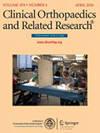Which Interventions Are Effective in Treating Sleep Disturbances After THA or TKA? A Systematic Review.
IF 4.2
2区 医学
Q1 ORTHOPEDICS
引用次数: 0
Abstract
BACKGROUND Poor sleep quality is a common complaint after total joint arthroplasty (TJA), and it is associated with reports of higher pain and worse functional outcomes. Several interventions have been investigated with the intent to reduce the incidence of postoperative sleep disturbance with varying effectiveness. An aggregate of the best available evidence, along with an evaluation of the quality of those studies, is needed to provide valuable perspective to physicians and to direct future research. QUESTIONS/PURPOSES In this systematic review, we asked: (1) What is the reported efficacy of the most commonly studied medications and nonpharmacologic approaches, and (2) what are their side effects and reported complications? METHODS This systematic review was conducted in line with the Preferred Reporting Items for Systematic Reviews and Meta-Analyses (PRISMA) guidelines. A search using a combination of controlled vocabulary and keywords was performed utilizing Medline (Ovid), Embase (Ovid), Cochrane Central, and Web of Science databases from database inception to 2023, with the last search occurring October 24, 2023, to identify studies that evaluated a sleep intervention on the effect of patient-reported sleep quality after THA or TKA. Inclusion criteria were clinical trials, comparative studies, and observational studies on adult patients who underwent primary TKA or THA for osteoarthritis and who completed validated sleep questionnaires to assess sleep quality postoperatively. We excluded studies on patients younger than 18 years, patients with sleep apnea, TKA or THA because of trauma or conditions other than osteoarthritis, revision TJA, studies in languages other than English, and studies from nonindexed journals or preprint servers. Two investigators independently screened 1535 studies for inclusion and exclusion criteria and extracted data from the included studies. Ultimately, 14 studies were included in this systematic review, including 12 randomized controlled trials and 2 prospective comparative studies. A total of 2469 participants were included, with a mean ± SD age of 65 ± 7 years and 38% men in control groups and 65 ± 7 years and 39% men in intervention groups. Sleep quality questionnaires utilized included the Pittsburgh Sleep Quality Index, Self-Rating Scale of Sleep, 100-mm VAS - Sleep, Sleep Disturbance Numeric Rating Scale, Likert scales, and one institutionally designed questionnaire. Quality analysis was performed utilizing the Joanna Briggs Institute (JBI) Critical Appraisal Checklist for Randomized Controlled Trials, where higher scores of 13 indicated a more reliable study, and the Newcastle-Ottawa Quality Assessment Scale for Cohort Studies, where higher scores of 9 indicated a more reliable study and scores < 5 represented a high risk of bias. Two of the randomized controlled trials scored a 12 of 13, and the remaining 10 met every criteria of the JBI checklist. Both comparative studies scored 5 of 9 possible points of the Newcastle-Ottawa Scale. RESULTS Melatonin and selective cyclooxygenase-2 inhibitor rofecoxib were found to provide a clinically important benefit to sleep quality within the first postoperative week after TJA. However, rofecoxib was withdrawn from the market globally in 2004 over concerns about increased risk of cardiovascular events. Another cyclooxygenase-2 inhibitor, celecoxib, remains available. No other intervention demonstrated a clinical benefit. Side effects of melatonin include dizziness, headache, paresthesia, and nausea, and it is contraindicated in patients with liver failure, autoimmune conditions, or who are receiving warfarin. Long-term adverse effects of rofecoxib include hypertension, edema, and congestive heart failure, and it is contraindicated in patients with renal insufficiency or who are receiving warfarin. Melatonin is considered safe in older patients, but more caution should be taken with rofecoxib. CONCLUSION Owing to limited evidence in support of most of the interventions we studied, none of these interventions can be recommended for routine use after TJA. Melatonin and rofecoxib may provide a benefit to sleep quality in some patients, but physicians need to understand the adverse effects and contraindications before recommending these interventions. Additionally, rofecoxib is no longer commercially available. Future investigation is warranted to evaluate the effectiveness of interventions with minimal side effect profiles for providers to be able to make an informed decision about interventions for sleep improvement after TJA. LEVEL OF EVIDENCE Level III, therapeutic study.哪些干预措施能有效治疗 THA 或 TKA 后的睡眠障碍?系统综述。
背景睡眠质量差是全关节置换术(TJA)后的常见症状,与疼痛加剧和功能障碍相关。为了降低术后睡眠障碍的发生率,人们研究了多种干预措施,但效果不一。我们需要对现有的最佳证据进行汇总,并对这些研究的质量进行评估,以便为医生提供有价值的观点,并指导未来的研究。在本系统性综述中,我们提出了以下问题:(1)最常研究的药物和非药物方法的疗效如何;(2)它们的副作用和并发症如何?在 Medline (Ovid)、Embase (Ovid)、Cochrane Central 和 Web of Science 数据库中结合使用控制词汇和关键词进行了检索,检索时间从数据库建立之初到 2023 年,最后一次检索时间为 2023 年 10 月 24 日,以确定评估睡眠干预对 THA 或 TKA 术后患者报告的睡眠质量影响的研究。纳入标准为临床试验、比较研究和观察性研究,研究对象为因骨关节炎而接受初级 TKA 或 THA 的成年患者,他们在术后填写了有效的睡眠问卷以评估睡眠质量。我们排除了有关 18 岁以下患者、睡眠呼吸暂停患者、因创伤或骨关节炎以外的其他疾病而接受 TKA 或 THA、翻修 TJA 的研究、使用英语以外语言的研究以及来自非索引期刊或预印服务器的研究。两名研究人员根据纳入和排除标准独立筛选了 1535 项研究,并从纳入的研究中提取了数据。最终,14 项研究被纳入本系统综述,包括 12 项随机对照试验和 2 项前瞻性比较研究。共纳入了 2469 名参与者,对照组参与者的平均(±SD)年龄为 65 ± 7 岁,38% 为男性;干预组参与者的平均(±SD)年龄为 65 ± 7 岁,39% 为男性。采用的睡眠质量问卷包括匹兹堡睡眠质量指数、睡眠自评量表、100 毫米 VAS - 睡眠量表、睡眠障碍数字评定量表、李克特量表和一份机构设计的问卷。质量分析采用乔安娜-布里格斯研究所(JBI)的随机对照试验批判性评估核对表和纽卡斯尔-渥太华队列研究质量评估量表进行,前者得分越高(13 分)表示研究越可靠,后者得分越高(9 分)表示研究越可靠,得分小于 5 分表示偏倚风险高。在 13 项随机对照试验中,有两项获得了 12 分,其余 10 项符合 JBI 检查表的所有标准。结果发现,褪黑素和选择性环氧化酶-2抑制剂罗非昔布可在TJA术后第一周内为睡眠质量提供具有临床意义的益处。然而,由于担心增加心血管事件的风险,罗非昔布已于 2004 年从全球市场上撤下。另一种环氧化酶-2 抑制剂塞来昔布仍在市场上销售。其他干预措施均未显示出临床疗效。褪黑素的副作用包括头晕、头痛、麻痹和恶心,肝功能衰竭、自身免疫性疾病或正在服用华法林的患者禁用。罗非昔布的长期不良反应包括高血压、水肿和充血性心力衰竭,肾功能不全或正在服用华法林的患者禁用。褪黑素在老年患者中被认为是安全的,但使用罗非昔布时则应更加谨慎。褪黑素和罗非昔布可能对某些患者的睡眠质量有益,但医生在推荐这些干预措施之前需要了解其不良反应和禁忌症。此外,罗非昔布已不再在市场上销售。未来有必要进行调查,以评估副作用最小的干预措施的有效性,从而使医疗人员能够就TJA术后改善睡眠的干预措施做出明智的决定。
本文章由计算机程序翻译,如有差异,请以英文原文为准。
求助全文
约1分钟内获得全文
求助全文
来源期刊
CiteScore
7.00
自引率
11.90%
发文量
722
审稿时长
2.5 months
期刊介绍:
Clinical Orthopaedics and Related Research® is a leading peer-reviewed journal devoted to the dissemination of new and important orthopaedic knowledge.
CORR® brings readers the latest clinical and basic research, along with columns, commentaries, and interviews with authors.
文献相关原料
| 公司名称 | 产品信息 | 采购帮参考价格 |
|---|

 求助内容:
求助内容: 应助结果提醒方式:
应助结果提醒方式:


